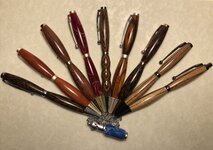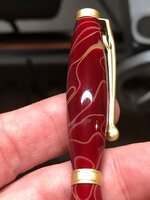yovalmtp
Member
I am new to turning and have made about 30-40 pens so far. I noticed pitting on an acrylic pen I turned about a month ago. When I finished it, it had a glass like surface with no blemishes. Now there are little pits or dimples forming. Has anyone had this happen before? What causes it? How do I prevent it? How do I fix it? I am posting my finishing technique because I am also seeing deterioration in the CA finish on my wood pens (small dimples in some cases and larger voids in others) and believe that I am doing something wrong. All my supplies are from Penn State Industries.
1. Turn to shape.
2. Initial sanding:
Wood/CA:
a. Dry sand wood: 150/240/320/400/600 grit, lathe turning 2000 rpm then long wise with lathe off. Clean the wood with alcohol to remove fine dust.
b. Apply CA: Gluboost blue 3-4 coats, Gluboost orange 3-4 coats with lathe turning at 700 rpm using a foam strip as applicator. I use Gluboost accelerator after each coat and let set ~1 minute between coats. Let set overnight before sanding.
c. Dry CA sand with 600 grit paper to take out ridges, lathe turning 2000 rpm then long wise with lathe off.
Acrylic: Dry sand 600 grit paper, lathe turning 2000 rpm then long wise with lathe off.
5. Both CA and Acrylic: Wet sand with plastic finishing pads, 800/1500/2400/4000/12000 grit, lathe turning 900 rpm then long wise with lathe off.
6. Both CA and Acrylic: Apply One-Step plastic polish long wise with lathe off and with blue shop paper towel till clear, then buff with shop towel at 900 rpm. Do this step twice.
7. Both CA and Acrylic: Buff with 4" cotton wheel using the Acrylic Buffing Bar for the Acrylic Pen Buffing System.
I don't know if this helps any, but I store my pens in a portfolio with 1" elastic straps and noticed the strap texture embedded in my CA finish. I apologize for the long post and appreciate and feedback.
Lee
1. Turn to shape.
2. Initial sanding:
Wood/CA:
a. Dry sand wood: 150/240/320/400/600 grit, lathe turning 2000 rpm then long wise with lathe off. Clean the wood with alcohol to remove fine dust.
b. Apply CA: Gluboost blue 3-4 coats, Gluboost orange 3-4 coats with lathe turning at 700 rpm using a foam strip as applicator. I use Gluboost accelerator after each coat and let set ~1 minute between coats. Let set overnight before sanding.
c. Dry CA sand with 600 grit paper to take out ridges, lathe turning 2000 rpm then long wise with lathe off.
Acrylic: Dry sand 600 grit paper, lathe turning 2000 rpm then long wise with lathe off.
5. Both CA and Acrylic: Wet sand with plastic finishing pads, 800/1500/2400/4000/12000 grit, lathe turning 900 rpm then long wise with lathe off.
6. Both CA and Acrylic: Apply One-Step plastic polish long wise with lathe off and with blue shop paper towel till clear, then buff with shop towel at 900 rpm. Do this step twice.
7. Both CA and Acrylic: Buff with 4" cotton wheel using the Acrylic Buffing Bar for the Acrylic Pen Buffing System.
I don't know if this helps any, but I store my pens in a portfolio with 1" elastic straps and noticed the strap texture embedded in my CA finish. I apologize for the long post and appreciate and feedback.
Lee


